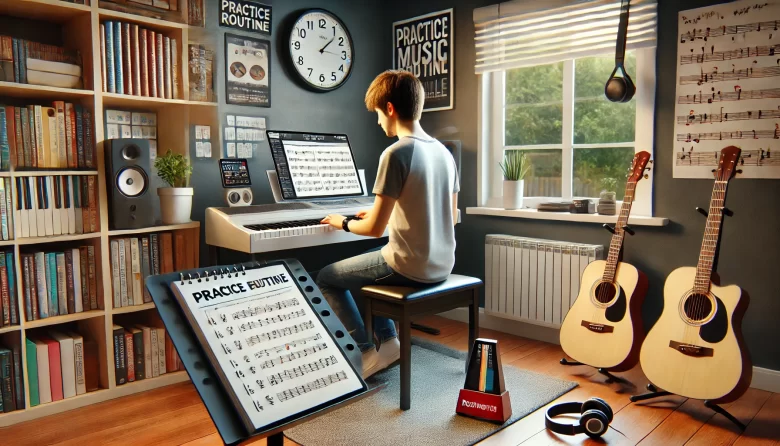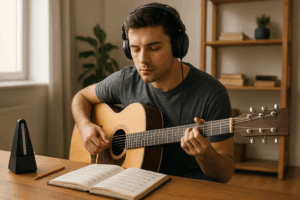One of the most powerful tools any beginner can use to improve their musical skills is not just the instrument itself — but a consistent, thoughtful practice routine. It’s easy to assume that talent or expensive gear makes the difference, but in truth, it’s what you do every day that shapes your musical journey.
A well-structured routine helps you learn faster, retain more, build discipline, and — most importantly — enjoy the process. In this article, we’ll explore why a routine is so essential and how you can build one that works for you, even with a busy schedule.
Why Having a Practice Routine Matters
A routine gives your practice structure, consistency, and direction. Without it, you’re more likely to skip practice, waste time, or get stuck playing only what you already know.
Here’s what a solid practice routine can do:
- Build muscle memory and coordination faster.
- Reinforce good habits while minimizing bad ones.
- Keep you motivated by showing clear progress.
- Make your time more efficient, so you improve faster.
- Prevent frustration, since you’ll have goals and a plan.
Learning music is like learning a language or a sport. Regular repetition and focused attention are key to getting better — and a routine ensures you’re doing just that.
Common Reasons Beginners Avoid Routines
Many new musicians shy away from routines because they associate them with rigidity or boredom. But the truth is, a good routine is both flexible and personal.
Some common objections:
- “I don’t have enough time.”
- “I just want to play for fun.”
- “I never stick to routines.”
- “I don’t know what to include in a practice session.”
These are valid concerns — but they can all be addressed. A routine doesn’t mean hours of boring drills. It means having a plan that works for you, your schedule, and your goals.
How to Build an Effective Practice Routine
Let’s break down how you can create a simple, effective practice structure that adapts to your life and evolves with your skills.
Step 1: Set Clear, Achievable Goals
Start by identifying what you want to achieve with your practice. Your goals can be short-term or long-term, big or small.
Examples:
- Learn to play a specific song in two weeks.
- Improve finger independence on the guitar.
- Learn to read sheet music.
- Master major and minor scales.
- Improve rhythm and timing with a metronome.
Having a goal gives your practice purpose. Without one, it’s easy to wander or lose focus.
Step 2: Determine Your Available Time
Be realistic about how much time you can devote to music daily or weekly. Even 15 to 30 minutes a day can produce great results if used wisely.
Tips:
- Short, frequent sessions are better than long, inconsistent ones.
- If possible, practice at the same time every day to build a habit.
- Use timers to keep yourself on track during each segment.
Consistency is more powerful than intensity. Daily practice, even in short bursts, builds momentum and motivation.
Step 3: Divide Your Practice Into Sections
A well-balanced practice routine should include different types of exercises that target specific skills. Here’s a common and effective breakdown:
1. Warm-Up (5–10 minutes)
Prepare your fingers, voice, or breath depending on your instrument.
- Scales
- Arpeggios
- Simple technical drills
- Breathing exercises (for wind instruments or voice)
2. Technical Work (10–15 minutes)
Build your foundation.
- Finger independence
- Chord transitions
- Bowing or picking technique
- Sight-reading
3. Repertoire (10–15 minutes)
Work on songs or pieces you want to play.
- Break it into small sections.
- Focus on problem areas.
- Use a metronome to develop timing.
4. Creative Practice (Optional)
Keep it fun and personal.
- Improvise
- Compose
- Experiment with effects or loops
- Play by ear
This is where your personality as a musician can grow.
5. Cool Down & Review (5 minutes)
Wrap up by reviewing what you worked on.
- Reflect on progress.
- Set a mini-goal for next time.
- End with something you enjoy playing.
Step 4: Keep It Flexible
Your routine should be a guide, not a prison. Some days you’ll feel more focused, others more creative. That’s okay.
Suggestions:
- Adjust your time depending on your energy level.
- If you’re stuck, focus on just one section.
- Once a week, have a “free play” session to just explore and enjoy music.
The key is to stay consistent, not perfect.
Tools That Help You Stay on Track
In today’s digital age, there are great resources to help you stick with your routine.
- Practice journal: Write down what you practiced, how it felt, and what to do next.
- Apps like Tunable, Yousician, or Simply Piano for feedback and structure.
- Timers and alarms to schedule your sessions.
- Video recording: Watch your progress and catch mistakes.
These tools add accountability and can make practicing more engaging and rewarding.
Staying Motivated Over Time
Even with a routine, it’s normal to feel discouraged or bored sometimes. The key is knowing how to reignite your enthusiasm.
Try These:
- Change your repertoire: Learn a new song or genre.
- Join a community: Share your progress on social media or in forums.
- Take lessons: Even once a month can offer huge clarity and inspiration.
- Record yourself weekly: Listening back shows your improvement over time.
- Celebrate small wins: Every new chord or clean transition counts.
You don’t need to love every minute — you just need to keep going.
Your Routine, Your Results
Building a practice routine might sound like a chore at first, but it’s actually your biggest ally. It turns small, daily actions into long-term growth. It replaces randomness with clarity. And it transforms music from something you dabble in… into something you grow in, deeply and consistently.
Remember: you don’t need a perfect routine. You just need one that works for you.
Be patient with the process, celebrate your progress, and enjoy every step of the way. Music is a journey, and your routine is the roadmap that keeps you moving forward.




